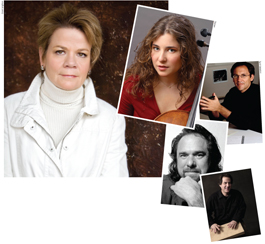home | metro santa cruz index | features | santa cruz | feature story

All-star lineup: Clockwise from top left: Festival Music Director Marin Alsop, cellist Alisa Weilerstein, composer Osvaldo Golijov, composer Lee Johnson and percussionist Jamey Haddad.
At Continent's Edge
Once again, the Cabrillo Festival shows why it's the premier American venue for contemporary music
By Scott MacClelland
WITHOUT looking in the mirror, I'd never imagine that I'd become a senior citizen. Some of us are crooning "Baubles, Bangles and Beads"--with apologies to Borodin--while others of us are humming the Jewel Song from Gounod's Faust. We of the older set may be forgiven, as our craving for the next treasure chest of new music is intensifying ahead of this Friday's opening night of the Cabrillo Festival of Contemporary Music.
The CabMuFest--our favorite nickname--doesn't just offer the best of today's leading American composers, to say nothing of their genius counterparts from other countries. It also proves, summer after summer, that there is a great hunger for excellent new music and, just as important, one that spans many generations. Just look at the Cabrillo audiences. Where else do we see music lovers from their 20s through their 90s gathered with keen anticipation for music none of us has ever heard before?
My own appetite is whetted sharply by Osvaldo Golijov's Azul, featuring the young cellist Alisa Weilerstein, on Aug. 7, opening night, and Magnus Lindberg's Seht die Sonne (Behold the Sun) on Aug. 15. My intrigue for Golijov's music comes from hearing several CDs of his music. Azul, which takes its name from the blue sky (at Tanglewood, specifically), is a four-movement cello concerto originally composed for Yo-Yo Ma. But Golijov wasn't entirely happy with that version, and, in tandem with Weilerstein, reworked it. Along the way, he picked some inspiration from Pablo Neruda's poem "The Heights of Macchu Picchu." "In the poem, there's this person that's sort of floating in the air, then he reaches into the very inside of the Earth and comes out again," Weilerstein told The New York Times. "It's that sort of emotional journey that we're trying to get through the piece."
My interest in Lindberg came from hearing his Concerto for Orchestra during the 2005 Cabrillo Festival and reading raves for Seht die Sonne by previous skeptics, including Joshua Kosman in the San Francisco Chronicle.
While I am acquainted with several other composers who will be in attendance, some of them are new to me. In these cases, the crutch of familiarity isn't available when writing reviews for publication. So, I take my place in the audience with little better advantage than the person in the next seat, rather than having pored over the program notes just in time and, perhaps, having visited the composers' websites beforehand. We, and indeed the musicians themselves, are all in this together for the first time. For the many West Coast premieres, it's like making history. For the world premieres, it is making history.
Lee Johnson's Dead Symphony no. 6 will actually be familiar to some, having been available on a critically praised CD for some while. The 12-movment score will be heard at this Sunday night's concert, the 14th anniversary of the death of Jerry Garcia, lead guitarist of one of the most inimitable bands in rock history. Among their accomplishments, the Grateful Dead made imitation virtually impossible, spontaneous improvisation being one of their hallmarks.
And where better? Thanks to Prof. Fred Lieberman, the UC-Santa Cruz library houses the Grateful Dead archive. Unlike Lieberman, Johnson was not a Deadhead. But he was a symphonic composer who takes inspiration from American circumstances--with such titles as Southern Textiles, Planned Communities, Sandfloor Cathedral, Infinitude and Social Engineering among them--and was approached by a Grateful Dead fan who saw the legacy of Garcia and company as worthy of a place in the American symphonic pantheon. "I had to start from scratch, do all the research, before I began to compose," Johnson says of his Dead Symphony (number six of nine so far.) The composer believes strongly in linking his works to contemporary American history, not least its social issues. His third symphony, Trail of Tears, focuses on the Cherokee and uses an American Indian choir and traditional flute. "We actually have a culture that belongs to us," he says, as if American composers have tended to overlook the obvious, "to explore our highs and lows through music." If the Dead Symphony is not familiar, the Grateful Dead tunes should be, even when all gussied up in full-fledged orchestral attire.
The parade of composers attending this festival, including the aforementioned, adds Enrico Chapela, whose Inguesu recreates Mexico's historic 1999 defeat of Brazil in the FIFA Confederations Cup final in Mexico City. Under Marin Alsop's direction, it gets its West Coast premiere this Saturday. The nine-minute symphonic poem enacts the match, play by thrilling play. The piece also pays homage to the great Mexican composer, Carlos Chavez, who served as Cabrillo Festival music director in the early 1970s.
THE CABRILLO FESTIVAL OF CONTEMPORARY MUSIC runs through Aug. 16. Most performances are at the Santa Cruz Civic Auditorium, 307 Church St., Santa Cruz. For festival schedule visit www.cabrillomusic.org. Tickets are $30-$50 (except for a handful of free performances; for those, see page 19) at www.santacruztickets.com or 831.420.5260.Send a letter to the editor about this story.
|
|
|
|
|
|